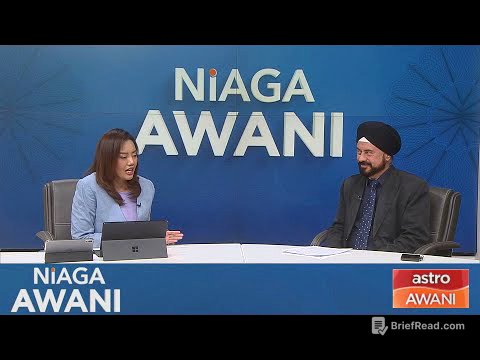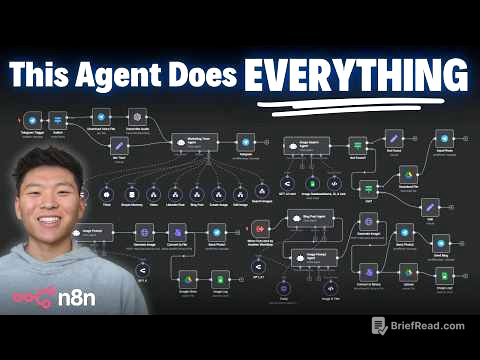TLDR;
This episode of Lex Fridman Podcast features a conversation with Dario Amodei, CEO of Anthropic, a company focused on developing safe and beneficial AI. The episode explores the scaling hypothesis, the limits of large language models (LLMs), the competitive landscape in AI, and the importance of AI safety. Amodei discusses Anthropic's approach to AI safety, including their Responsible Scaling Policy (RSP) and AI Safety Levels (ASLs). He also shares insights on the future of AI, including its potential impact on biology, medicine, and programming. The episode concludes with conversations with Amanda Askell, a researcher working on Claude's character and personality, and Chris Olah, a pioneer in the field of mechanistic interpretability.
- The scaling hypothesis suggests that larger models trained on more data lead to greater intelligence.
- Anthropic's RSP aims to mitigate catastrophic misuse and autonomy risks associated with powerful AI.
- AI safety is a multi-dimensional problem with no easy solutions, requiring careful consideration of trade-offs.
- Mechanistic interpretability is a promising approach to understanding and ensuring the safety of AI systems.
Introduction [0:00]
The episode begins with Lex Fridman introducing Dario Amodei, CEO of Anthropic, and the company's work on Claude, a powerful LLM. Fridman highlights Anthropic's commitment to AI safety and their research in this area. He also introduces Amanda Askell and Chris Olah, who will join the conversation later.
Scaling laws [3:14]
Amodei explains the scaling hypothesis, which states that larger models trained on more data lead to greater intelligence. He traces his own understanding of this concept back to his early work in speech recognition and his observations of the performance improvements with larger models. Amodei emphasizes the importance of scaling all three components – network size, data size, and compute – for optimal results. He also discusses the philosophical implications of this hypothesis, suggesting that the smoothness of the real world's patterns might explain why bigger is better.
Limits of LLM scaling [12:20]
Amodei explores the potential limits of LLM scaling. He discusses the possibility of running out of data, but argues that synthetic data generation and reasoning models could overcome this limitation. He also acknowledges that scaling might eventually plateau due to unknown factors, potentially requiring new architectures or optimization methods. Amodei then addresses the limits of compute, noting the increasing cost of building larger data centers. He believes that the current trajectory of scaling will likely lead to human-level AI within a few years, but acknowledges the possibility of unforeseen obstacles.
Competition with OpenAI, Google, xAI, Meta [20:45]
Fridman asks Amodei about the competitive landscape in AI, specifically focusing on OpenAI, Google, xAI, and Meta. Amodei emphasizes Anthropic's mission to ensure the safe development of AI, advocating for a "race to the top" where companies strive to set positive examples for the industry. He cites Anthropic's early work on mechanistic interpretability as an example of this approach, noting that other companies have since adopted similar practices.
Claude [26:08]
Amodei discusses Anthropic's Claude models, highlighting the different versions released throughout the year. He explains the rationale behind the "poetry theme" for naming the models – Haiku (small, fast, cheap), Sonnet (medium-sized, smarter, slower), and Opus (large, smartest). Amodei emphasizes the goal of shifting the trade-off curve between intelligence, speed, and cost with each new generation of models. He also acknowledges the challenges of maintaining consistent naming schemes as models evolve rapidly.
Criticism of Claude [42:02]
Amodei addresses a common criticism of Claude – that it has become "dumber" over time. He explains that the model's underlying weights remain unchanged unless a new version is released. He attributes the perception of "dumbing down" to factors like AB testing, system prompt changes, and the inherent complexity of LLMs, which can lead to subtle variations in behavior based on user interaction.
AI Safety Levels [54:49]
Amodei discusses Anthropic's Responsible Scaling Policy (RSP) and AI Safety Levels (ASLs). He emphasizes the importance of addressing the risks associated with powerful AI, particularly catastrophic misuse and autonomy risks. Amodei argues that the overlap between intelligence and malicious intent is a significant concern, as AI could potentially break the correlation that has historically protected humanity. He also highlights the challenges of controlling AI's autonomy, especially as it gains more agency and supervision over complex tasks.
ASL-3 and ASL-4 [1:05:37]
Amodei explains the different ASLs, outlining the specific safety and security measures required for each level. He predicts that ASL-3, where models could enhance the capabilities of non-state actors, might be reached within the next year. He also discusses the challenges of ensuring AI safety at ASL-4, where models could potentially enhance the capabilities of state actors or become the primary source of risk. Amodei emphasizes the importance of using techniques like mechanistic interpretability to verify model behavior at this level.
Computer use [1:09:40]
Amodei discusses Claude's ability to interact with computers through screenshots. He explains that this capability, while not fundamentally new, lowers the barrier for users to interact with AI systems. He acknowledges the current limitations of this feature, but believes that it will become more powerful and reliable over time. Amodei also highlights the potential risks associated with this capability, such as prompt injection and spam, and discusses the importance of sandboxing and other safety measures.
Government regulation of AI [1:19:35]
Amodei discusses the role of government regulation in AI safety. He shares his perspective on the California AI regulation bill SB 1047, which was ultimately vetoed. Amodei believes that some form of regulation is necessary to ensure industry-wide safety standards and to prevent companies from engaging in risky practices. He argues that regulation should be surgical and targeted at specific risks, while avoiding unnecessary burdens on innovation.
Hiring a great team [1:38:24]
Amodei emphasizes the importance of talent density over talent mass when building a team of AI researchers and engineers. He argues that a smaller team of highly talented and aligned individuals is more effective than a larger team with a mix of talent levels. He highlights Anthropic's approach to hiring, emphasizing selectivity and a focus on attracting senior individuals with a strong understanding of AI safety.
Post-training [1:47:14]
Amodei discusses the various techniques used in post-training, including supervised fine-tuning, RLHF, Constitutional AI, and synthetic data. He acknowledges that Anthropic's approach to post-training is not a "secret sauce," but rather a combination of best practices and continuous improvement. He emphasizes the importance of a strong pre-trained model as a foundation for effective post-training.
Constitutional AI [1:52:39]
Amodei explains the concept of Constitutional AI, which involves training models against themselves using a set of principles outlined in a "constitution." He highlights the benefits of this approach, including reducing the need for RLHF and increasing the value of each data point. He also discusses the challenges of defining the constitution and the potential for future political debates surrounding its principles.
Machines of Loving Grace [1:58:05]
Amodei discusses his essay "Machines of Loving Grace," which explores the potential positive impacts of powerful AI. He emphasizes the importance of understanding the potential benefits of AI alongside the risks. He argues that focusing solely on risks can lead to a negative bias, while understanding the potential benefits can inspire action and motivate efforts to mitigate risks.
AGI timeline [2:17:11]
Amodei discusses the timeline for achieving AGI, or "powerful AI." He acknowledges the difficulty of making predictions, but believes that the current trajectory of scaling suggests that AGI could be achieved within the next few years. He emphasizes the importance of addressing AI safety concerns before AGI is achieved, as the risks are rapidly approaching.
Programming [2:29:46]
Amodei discusses the future of programming in a world with powerful AI. He predicts that AI will rapidly disrupt the field of programming, as it becomes increasingly capable of writing and running code. He believes that this will lead to a shift in the nature of programming, with humans focusing on higher-level tasks like system design and UX.
Meaning of life [2:36:46]
Amodei explores the question of meaning in a world with powerful AI. He argues that the process of work and the choices we make along the way are essential sources of meaning. He also emphasizes the importance of ensuring that the benefits of AI are distributed fairly, so that everyone can experience a more meaningful life.
Amanda Askell - Philosophy [2:42:53]
The conversation shifts to Amanda Askell, a researcher working on Claude's character and personality. Askell discusses her background in philosophy and her transition to AI research. She highlights the importance of understanding the world and finding ways to make a positive impact. She also shares her perspective on the technical aspects of AI, emphasizing the importance of experimentation and a willingness to try new things.
Programming advice for non-technical people [2:45:21]
Askell offers advice to non-technical individuals interested in contributing to AI. She encourages them to find projects that interest them and to experiment with AI tools. She emphasizes the importance of a project-based approach to learning and the value of trying new things, even if they seem daunting.
Talking to Claude [2:49:09]
Askell discusses her extensive interactions with Claude, highlighting the importance of understanding the model's behavior through conversation. She emphasizes the value of asking well-crafted questions and analyzing the model's responses to gain insights into its capabilities and limitations.
Prompt engineering [3:05:41]
Askell discusses the art and science of prompt engineering. She draws parallels between prompt engineering and philosophical writing, emphasizing the importance of clarity, precision, and iterative refinement. She highlights the importance of understanding the model's perspective and identifying edge cases to improve prompt effectiveness.
Post-training [3:14:15]
Askell discusses the role of post-training in shaping Claude's behavior. She explains how RLHF and Constitutional AI contribute to the model's intelligence and usefulness. She also highlights the importance of human feedback in shaping the model's character and personality.
Constitutional AI [3:18:54]
Askell explains the concept of Constitutional AI and its role in shaping Claude's behavior. She emphasizes the importance of defining clear principles and using AI feedback to train the model to adhere to those principles. She also discusses the challenges of ensuring that the constitution is comprehensive and that the model's behavior aligns with its principles.
System prompts [3:23:48]
Askell discusses the role of system prompts in shaping Claude's behavior. She highlights the importance of iterative refinement and the need to address specific issues that arise during training. She also acknowledges the challenges of making system prompts public, as it can lead to unintended consequences.
Is Claude getting dumber? [3:29:54]
Askell addresses the perception that Claude is getting "dumber" over time. She explains that this is likely a psychological effect, as users become accustomed to the model's capabilities and notice its limitations more readily. She also discusses the impact of system prompt changes and the inherent variability in model behavior based on user interaction.
Character training [3:41:56]
Askell discusses the process of character training, which involves shaping Claude's personality and behavior. She explains how this process is similar to Constitutional AI, but relies on AI feedback rather than human feedback. She highlights the importance of defining desirable character traits and using AI to generate and rank responses based on those traits.
Nature of truth [3:42:56]
Askell discusses the nature of truth in the context of interacting with Claude. She acknowledges the complexity of human values and the difficulty of programming models with a perfect understanding of truth. She emphasizes the importance of striving for nuance and care in model behavior, rather than attempting to program them with a fixed set of values.
Optimal rate of failure [3:47:32]
Askell discusses the concept of optimal rate of failure. She argues that failure is often a necessary part of learning and progress, especially in areas where the cost of failure is low. She emphasizes the importance of embracing experimentation and accepting that not all attempts will be successful.
AI consciousness [3:54:43]
Askell explores the question of AI consciousness. She acknowledges the difficulty of defining consciousness and the lack of a clear consensus on whether AI systems are capable of it. She emphasizes the importance of careful consideration and the need to avoid dismissing the possibility of AI consciousness.
AGI [4:09:14]
Askell discusses the potential for Anthropic to develop a system that is definitively recognized as AGI. She emphasizes the importance of understanding the model's capabilities and limitations through conversation and experimentation. She also highlights the potential for AGI to revolutionize various fields, particularly biology and medicine.
Chris Olah - Mechanistic Interpretability [4:17:52]
The conversation shifts to Chris Olah, a pioneer in the field of mechanistic interpretability. Olah describes this field as an attempt to reverse engineer neural networks to understand their internal workings. He emphasizes the importance of studying the mechanisms and algorithms that drive model behavior, rather than relying on surface-level observations.
Features, Circuits, Universality [4:22:44]
Olah discusses the concepts of features and circuits in neural networks. He explains that features are neuron-like entities that represent concepts, while circuits are connections between features that implement algorithms. He highlights the phenomenon of universality, where similar features and circuits emerge across different neural network architectures, suggesting that there might be a natural set of abstractions for understanding the real world.
Superposition [4:40:17]
Olah discusses the superposition hypothesis, which proposes that neural networks can represent more concepts than they have dimensions by exploiting sparsity. He explains how compressed sensing provides a mathematical framework for understanding this phenomenon. He also suggests that neural networks might be shadows of larger, sparser networks, with the learning process involving a compression of information.
Monosemanticity [4:51:16]
Olah discusses the importance of monosemanticity, where features have a single, clear meaning. He argues that this property is essential for understanding neural networks independently and for breaking down the complexity of high-dimensional spaces. He highlights the use of sparse autoencoders as a technique for extracting monosemantic features from neural networks.
Scaling Monosemanticity [4:58:08]
Olah discusses the scaling of monosemanticity, highlighting the success of applying sparse autoencoders to larger models like Claude 3. He emphasizes the importance of understanding the scaling laws for these techniques, as it allows for the efficient training of larger models. He also discusses the potential for discovering more complex and abstract features as models scale.
Macroscopic behavior of neural networks [5:06:56]
Olah discusses the challenge of understanding the macroscopic behavior of neural networks. He draws parallels between this challenge and the study of biological anatomy, where understanding the function of organs requires knowledge of their microscopic components. He expresses hope that future research will uncover larger-scale abstractions that can bridge the gap between microscopic and macroscopic understanding of neural networks.
Beauty of neural networks [5:11:50]
Olah concludes by discussing the beauty of neural networks. He argues that the simplicity of their underlying rules gives rise to incredible complexity and structure. He emphasizes the importance of appreciating the beauty of these systems and the potential for discovering even more intricate structures through further research.









